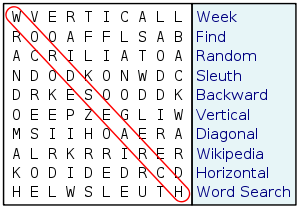Word search

A word search, word find, word seek, word sleuth or mystery word puzzle is a word game that consists of the letters of words placed in a grid, which usually has a rectangular or square shape. The objective of this puzzle is to find and mark all the words hidden inside the box. The words may be placed horizontally, vertically, or diagonally. Often a list of the hidden words is provided, but more challenging puzzles may let the player figure them out. Many word search puzzles have a theme to which all the hidden words are related. The puzzles have, like crosswords and arrowords, been very popular in the United Kingdom, and - also in common with these latter puzzles - have had complete magazines devoted to them.
Word searches are commonly found in daily newspapers and puzzle books. Some teachers use them as educational tools for children, the benefit being that young minds can learn new words and their spellings by intensively searching for them, letter by letter, in the puzzle.
Strategies
A common strategy for finding all the words is to go through the puzzle left to right (or vice versa) and look for the first letter of the word (if a word list is provided). After finding the letter, one should look at the eight surrounding letters to see whether the next letter of the word is there. One can then continue this method until the entire word is found.
Another strategy is to look for 'outstanding' letters within the word one is searching for (if a word list is provided). Since most word searches use capital letters, it is easiest to spot the letters that stand out from others. These letters are Q, O, U, X, and Z.
Lastly, the strategy of looking for double letters in the word being searched for (if a word list is provided) proves helpful, because it is easier to spot two identical side-by-side letters among a large grid of random letters.
If a word list is not provided, a way to find words is to go row by row. First, all the horizontal rows should be read both backwards and forwards, then the vertical, and so on.
Sometimes the puzzle itself will help. The puzzles generated by a computer tend to put words in patterns. Furthermore, the bigger the words and the more words, the easier they are to spot. In some computer-generated puzzles, if the person solving the puzzle sees one word, all they have to do to find more is to look in adjacent rows, columns, or diagonals. The puzzle might use every row, column, or diagonal—or just every other row, column, or diagonal.
History
The word search puzzle (also known as WordSeek, WordFind, WonderWord, etc.) was originally designed and published by Norman E. Gibat in the Selenby Digest on March 1, 1968 in Norman, Oklahoma, although the Spanish puzzle creator Pedro Ocón de Oro was publishing "Sopas de letras" (Spanish "Soup of Letters") before that date.
Selenby was a small want-ad digest distributed free at Safeway and other stores in the town. The original page size is 8.5 by 5.5 inches.
The puzzle was very popular locally and several more followed this original. Some teachers in the Norman schools asked for reprints to use in their classes. One teacher sent them around the country to various friends in other schools. Undoubtedly one of these scattered copies eventually led somebody to sell the idea to a syndicator.
Secret messages
Sometimes secret messages are hidden in the word search. In one variation, the secret message is created by all the words that are written backwards in the puzzle. In another variation, the secret message is created by the letters that are not used in any word within the puzzle. This variation is more common in more difficult puzzles where most letters are used. Kappa Publishing is well known for this. They Magazines are called " The Magazine with the Last Message" or other saying that is related.
Another type of word search puzzle contains a trivia question at the bottom. Like a traditional word search puzzle, words from a word list must be circled or crossed through in the puzzle. There is also one or more extra word or phrase hidden in the puzzle that is not in the word list. This word or phrase usually answers the trivia question at the bottom of the page.
Snaking puzzles
Some word search puzzles are snaking puzzles, in which the word is not a straight horizontal,or diagonal line, but "bends" at 90 degrees at any given letter. These are much more difficult than conventional puzzles.
Teaching
Word search puzzles are often used in a teaching or classroom environment, especially in language and foreign language classrooms. Some teachers, particularly those specializing in English as a Second Language (ESL), use word search puzzles as an instructional tool. Other teachers use them as a recreational activity for students, instead.
See also
External links
- Word Search at DMOZ